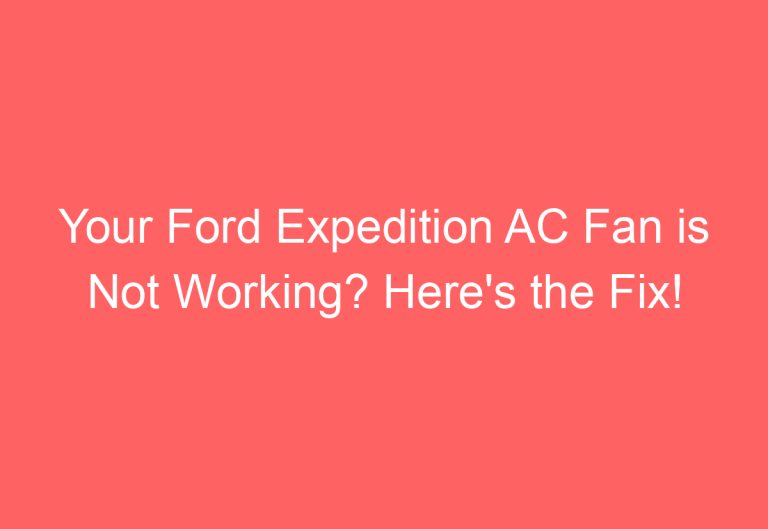Your Ford Expedition’s Brake Lights Aren’t Working? Here’s Why
Your Ford Expedition’s brake lights are an essential safety feature, but what happens when they stop working This is a common problem that can be frustrating and inconvenient, but it’s usually easy to fix. In this guide, we’ll walk you through the steps to troubleshoot the issue and get your brake lights working again.
We’ll start by explaining how brake lights work and what could cause them to stop working. Then, we’ll give you a step-by-step guide to testing your brake lights and diagnosing the problem. Finally, we’ll provide some tips on how to prevent this issue from happening again.
By the end of this guide, you’ll be able to fix your Ford Expedition’s brake lights so you can safely get back on the road.
Reasons Why Ford Expedition Brake Lights Not Working
Here are the reasons:
Brake Light Fuse
The brake light fuse is a common cause of brake lights not working. To check the fuse, look in the fuse box under the hood. The brake light fuse is usually a 15-amp fuse. If the fuse is blown, replace it with a new one.
Brake Light Switch
The brake light switch is another common cause of brake lights not working. The brake light switch is located on the brake pedal assembly. To check the brake light switch, turn on the headlights and depress the brake pedal. If the brake lights come on, the brake light switch is working properly. If the brake lights do not come on, the brake light switch is faulty and needs to be replaced.
Brake Light Bulbs
The brake light bulbs are another common cause of brake lights not working. To check the brake light bulbs, open the trunk of the vehicle and look at the brake light housing. If the brake light bulbs are burned out, replace them with new ones.
Wiring Problems
Wiring problems can also cause brake lights not to work. To check for wiring problems, use a voltmeter to check the voltage at the brake light sockets. If there is no voltage at the brake light sockets, there is a wiring problem. To fix the wiring problem, you will need to find the break in the wire and repair it.
How to Troubleshoot: Ford Expedition Brake Lights Not Working
Your Ford Expedition’s brake lights are an essential safety feature. They warn other drivers that you are slowing down or stopping, and they help to prevent accidents. If your brake lights are not working, it is important to get them fixed as soon as possible.
There are a few different things that could cause your Ford Expedition’s brake lights to stop working. In this article, we will discuss the most common causes and how to troubleshoot them.
Causes of Brake Light Problems
The most common cause of brake light problems is a blown fuse. Fuses are small, cylindrical devices that protect electrical circuits from damage. When a fuse blows, it interrupts the flow of electricity to the circuit, preventing damage to the wiring and other components.
Another common cause of brake light problems is a faulty brake light switch. The brake light switch is a mechanical switch that is activated when you press the brake pedal. When the switch is activated, it sends a signal to the brake lights, causing them to turn on. If the switch is faulty, it may not be able to send the signal to the brake lights, causing them to stay off.
Other possible causes of brake light problems include:
A faulty brake light bulb
A damaged brake light wiring harness
A problem with the brake light control module
Troubleshooting Brake Light Problems
If your Ford Expedition’s brake lights are not working, you can troubleshoot the problem yourself using the following steps:
1. Check the fuses:
The first thing you should do is check the fuses for the brake lights. The fuse box is located under the hood of your vehicle. The brake light fuses are usually labeled BRAKE LIGHTS or STOP LIGHTS.
To check the fuses, you will need a fuse tester. A fuse tester is a small, handheld device that allows you to test the continuity of a fuse.
To test the fuses, remove the fuse from the fuse box and insert it into the fuse tester. If the fuse tester lights up, the fuse is good. If the fuse tester does not light up, the fuse is blown and needs to be replaced.
2. Check the brake light switch:
The next thing you should check is the brake light switch. The brake light switch is located under the dashboard of your vehicle. To access the brake light switch, you will need to remove the dashboard panel.
Once you have access to the brake light switch, you can test it using a multimeter. A multimeter is a tool that allows you to measure the voltage of an electrical circuit.
To test the brake light switch, connect the positive lead of the multimeter to the + terminal of the switch and the negative lead of the multimeter to the – terminal of the switch.
Turn on the ignition and press the brake pedal. The multimeter should read 12 volts. If the multimeter does not read 12 volts, the brake light switch is faulty and needs to be replaced.
3. Check the brake light bulbs:
The next thing you should check is the brake light bulbs. The brake light bulbs are located in the rear of your vehicle. To access the brake light bulbs, you will need to remove the rear taillight assemblies.
Once you have access to the brake light bulbs, you can test them using a voltmeter. A voltmeter is a tool that allows you to measure the voltage of an electrical circuit.
To test the brake light bulbs, connect the positive lead of the voltmeter to the + terminal of the bulb and the negative lead of the voltmeter to the – terminal of the bulb.
Turn on the ignition and press the brake pedal. The voltmeter should read 12 volts. If the voltmeter does not read 12 volts, the brake light bulb is faulty and needs to be replaced.
4. Check the brake light wiring harness:
The next thing you should check is the brake light wiring harness. The brake light wiring harness is a bundle of wires that connects the brake light switch to the brake lights.
To check the brake light wiring harness, you will need to use a multimeter to check for continuity between the brake light switch and the brake lights.
To check for continuity, connect the positive lead of the multimeter to one end of the wire and the negative lead of the multimeter to the other end of the wire.
If the multimeter reads continuity, the wire is good. If the multimeter does not read continuity, the wire is damaged and needs to be replaced.
5. Check the brake light control module:
The final thing you should check is the brake light control module. The brake light control
Also Read: Ford Expedition Car Alarm Keeps Going Off
Frequently Asked Questions about Ford Expedition Brake Lights Not Working
1. Why are my Ford Expedition brake lights not working?
There are several potential reasons for malfunctioning brake lights in a Ford Expedition. This could be due to a blown fuse
a faulty brake light switch
a wiring issue
or a problem with the bulbs themselves.
2. How can I troubleshoot my Ford Expedition brake lights?
To troubleshoot the brake lights on your Ford Expedition
start by checking the fuse
then inspect the brake light switch and the wiring. Ensure that the bulbs are in good condition and properly connected. If the issue persists
it may require professional diagnosis and repair.
3. Can a bad brake light switch cause all brake lights to not work?
Yes
a faulty brake light switch can cause all the brake lights to stop working. The switch is responsible for activating the brake lights when the brake pedal is pressed. If it malfunctions
it can result in a complete loss of brake light function.
4. Are there specific brake light issues common to Ford Expeditions?
Some common brake light issues in Ford Expeditions include fuse failures
brake light switch malfunctions
and wiring problems. It’s important to address these issues promptly to ensure the safety of the vehicle.
5. When should I seek professional help for my Ford Expedition brake light issue?
If basic troubleshooting steps do not resolve the brake light problem
or if there are underlying electrical issues
it’s advisable to seek professional assistance. A certified mechanic can diagnose the problem accurately and perform the necessary repairs to ensure the proper functioning of the brake lights.




![2012 Ford Expedition Radio Display Not Working [Easy Fixes!]](https://automotiveglory.com/wp-content/uploads/2024/05/2012-ford-expedition-radio-display-not-working-easy-fixes_6479-768x529.jpg)

![1999 Ford Expedition Rear Wiper Not Working [Fix It For Good]](https://automotiveglory.com/wp-content/uploads/2024/05/1999-ford-expedition-rear-wiper-not-working-fix-it-for-good_6404-768x529.jpg)